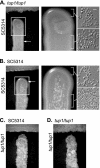Candida albicans Tup1 is involved in farnesol-mediated inhibition of filamentous-growth induction
- PMID: 18424510
- PMCID: PMC2446655
- DOI: 10.1128/EC.00357-07
Candida albicans Tup1 is involved in farnesol-mediated inhibition of filamentous-growth induction
Abstract
Candida albicans is a dimorphic fungus that can interconvert between yeast and filamentous forms. Its ability to regulate morphogenesis is strongly correlated with virulence. Tup1, a transcriptional repressor, and the signaling molecule farnesol are both capable of negatively regulating the yeast to filamentous conversion. Based on this overlap in function, we tested the hypothesis that the cellular response to farnesol involves, in part, the activation of Tup1. Tup1 functions with the DNA binding proteins Nrg1 and Rfg1 as a transcription regulator to repress the expression of hypha-specific genes. The tup1/tup1 and nrg1/nrg1 mutants, but not the rfg1/rfg1 mutant, failed to respond to farnesol. Treatment of C. albicans cells with farnesol caused a small but consistent increase in both TUP1 mRNA and protein levels. Importantly, this increase corresponds with the commitment point, beyond which added farnesol no longer blocks germ tube formation, and it correlates with a strong decrease in the expression of two Tup1-regulated hypha-specific genes, HWP1 and RBT1. Tup1 probably plays a direct role in the response to farnesol because farnesol suppresses the haploinsufficient phenotype of a TUP1/tup1 heterozygote. Farnesol did not affect EFG1 (a transcription regulator of filament development), NRG1, or RFG1 mRNA levels, demonstrating specific gene regulation in response to farnesol. Furthermore, the tup1/tup1 and nrg1/nrg1 mutants produced 17- and 19-fold more farnesol, respectively, than the parental strain. These levels of excess farnesol are sufficient to block filamentation in a wild-type strain. Our data are consistent with the role of Tup1 as a crucial component of the response to farnesol in C. albicans.
Figures





Similar articles
-
Apoptotic Factors, CaNma111 and CaYbh3, Function in Candida albicans Filamentation by Regulating the Hyphal Suppressors, Nrg1 and Tup1.J Microbiol. 2023 Apr;61(4):403-409. doi: 10.1007/s12275-023-00034-8. Epub 2023 Mar 27. J Microbiol. 2023. PMID: 36972003 Review.
-
Ahr1 and Tup1 Contribute to the Transcriptional Control of Virulence-Associated Genes in Candida albicans.mBio. 2020 Apr 28;11(2):e00206-20. doi: 10.1128/mBio.00206-20. mBio. 2020. PMID: 32345638 Free PMC article.
-
NRG1, a repressor of filamentous growth in C.albicans, is down-regulated during filament induction.EMBO J. 2001 Sep 3;20(17):4753-61. doi: 10.1093/emboj/20.17.4753. EMBO J. 2001. PMID: 11532939 Free PMC article.
-
Global roles of Ssn6 in Tup1- and Nrg1-dependent gene regulation in the fungal pathogen, Candida albicans.Mol Biol Cell. 2005 Jun;16(6):2913-25. doi: 10.1091/mbc.e05-01-0071. Epub 2005 Apr 6. Mol Biol Cell. 2005. PMID: 15814841 Free PMC article.
-
Co-regulation of pathogenesis with dimorphism and phenotypic switching in Candida albicans, a commensal and a pathogen.Int J Med Microbiol. 2002 Oct;292(5-6):299-311. doi: 10.1078/1438-4221-00215. Int J Med Microbiol. 2002. PMID: 12452278 Review.
Cited by
-
Zap1 control of cell-cell signaling in Candida albicans biofilms.Eukaryot Cell. 2011 Nov;10(11):1448-54. doi: 10.1128/EC.05196-11. Epub 2011 Sep 2. Eukaryot Cell. 2011. PMID: 21890817 Free PMC article.
-
Communication in fungi.Int J Microbiol. 2012;2012:351832. doi: 10.1155/2012/351832. Epub 2011 Sep 26. Int J Microbiol. 2012. PMID: 21961006 Free PMC article.
-
Molecular Determinants Involved in Candida albicans Biofilm Formation and Regulation.Mol Biotechnol. 2024 Jul;66(7):1640-1659. doi: 10.1007/s12033-023-00796-x. Epub 2023 Jul 6. Mol Biotechnol. 2024. PMID: 37410258 Review.
-
Influence of phosphatidylserine and phosphatidylethanolamine on farnesol tolerance in Candida albicans.Yeast. 2018 Apr;35(4):343-351. doi: 10.1002/yea.3297. Epub 2018 Feb 8. Yeast. 2018. PMID: 29143357 Free PMC article.
-
Physiological adventures in Candida albicans: farnesol and ubiquinones.Microbiol Mol Biol Rev. 2024 Mar 27;88(1):e0008122. doi: 10.1128/mmbr.00081-22. Epub 2024 Mar 4. Microbiol Mol Biol Rev. 2024. PMID: 38436263 Free PMC article. Review.
References
-
- Backen, A. C., I. D. Broadbent, R. W. Fetherston, J. D. Rosamond, N. F. Schnell, and M. J. Stark. 2000. Evaluation of the CaMAL2 promoter for regulated expression of genes in Candida albicans. Yeast 161121-1129. - PubMed
-
- Berman, J., and P. E. Sudbery. 2002. Candida albicans: a molecular revolution built on lessons from budding yeast. Nat. Rev. Genet. 3918-930. - PubMed
-
- Braun, B. R., and A. D. Johnson. 1997. Control of filament formation in Candida albicans by the transcriptional repressor TUP1. Science 277105-109. - PubMed
Publication types
MeSH terms
Substances
LinkOut - more resources
Full Text Sources
Other Literature Sources
Molecular Biology Databases

